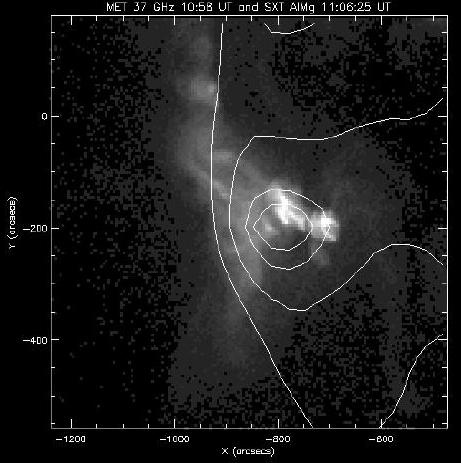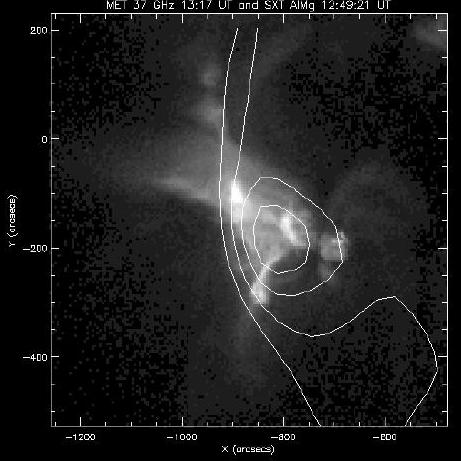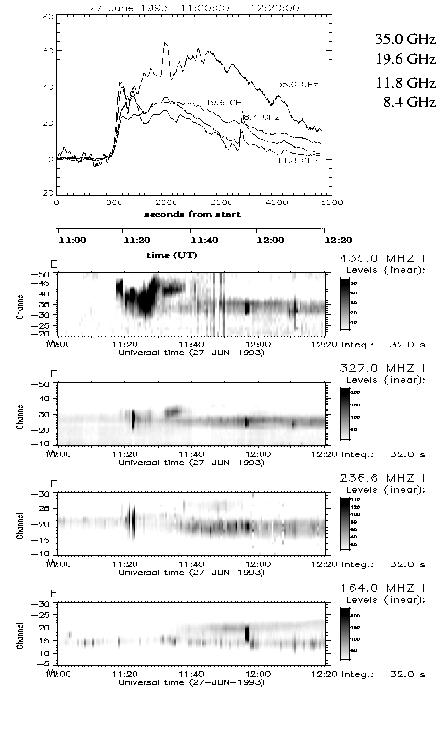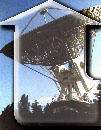Metsähovi Reports HUT-KURP-19
Metsähovi Radio Observatory
Annual Report 1999
S.Urpo, A. Mujunen (editors)
Helsinki University of Technology
Teknillinen korkeakoulu
Dr.Seppo Urpo
Tel.+358-9-2564 417
Email: Seppo.Urpo@hut.fi
Ms.Solveig Hurtta
Tel.+358-9-2564 831
Email: Solveig.Hurtta@hut.fi
Helsinki University of Technology
P.O.Box 3000
FIN-02015 HUT
Finland
Teknillinen korkeakoulu
Metsähovintie 114
02540 KYLMÄLÄ
1 Introduction
2 Research Activities
-
2.1 Radio Astronomical Instrumentation
-
2.2 Antenna Control System Upgrade
-
2.2.1 Dedicated Hardware
-
2.2.2 Cabling
-
2.2.3 Computers
-
2.2.4 Weather Stations
-
2.2.5 ADAM/NuDAM
-
2.2.6 Data Acquisition (A/D)
-
-
2.3 Extragalactic Radio Sources
-
2.3.1 Monitoring of Quasars
-
2.3.2 SEST Observations
-
-
2.4 Planck-Related Science in Metsähovi
-
2.5 Observations with Other Facilities
-
2.6 VLBI Research
-
2.6.1 EVN
-
2.6.2 CMVA, Coordinated Millimetre VLBI Array
-
2.6.3 Space VLBI
-
2.6.4 FS Support
-
-
2.7 Solar Research
-
2.7.1 Solar Data Analysis
-
2.7.2 Solar Polar Features at mm-Waves
-
2.7.3 Multi-wavelength Analysis of Energetic Solar Flares
-
2.7.4 High Latitude Active Regions
-
2.7.5 Space Weather Monitoring
-
2.7.6 INTAS
-
-
2.8 HRDL for Alpha Magnetic Spectrometer (AMS)
-
2.9 Radio Spectroscopy
3 Publications
-
3.1 International Journals
-
3.2 International Conferences
-
3.3 National Conferences
-
3.4 Laboratory Reports
-
3.5 Other Publications
4 Visits to Foreign Institutes
5 Visiting Scientists
6 Thesis
7 Teaching
8 Other Activities
-
8.1 Participation in Boards and Committees
-
8.2 International Meetings and Talks
-
8.3 National Meetings and Talks
-
8.4 Public Relations
9 Personnel in 1999
1 Introduction
The Metsähovi Radio Observatory, a separate research institute at the Helsinki University of Technology since May 1988, operates a 14-m diameter radio telescope at Metsähovi, Kylmälä, about 35km west from the university campus. The institute also has premises in the Electrical Engineering Faculty building, Otakaari5, Espoo. The main users of the station are the Helsinki University of Technology, the University of Helsinki, and the University of Turku. In the same area, near Metsähovi Radio Observatory, there are also the buildings of the Metsähovi Observatory (University of Helsinki; optical astronomy) and the Metsähovi Space Geodetic Station (Geodetic Institute; geodesy).
The Metsähovi Radio Observatory has been operational since 1974. The upgrading of the telescope was done during 1992-1994. The radome was replaced with a new one and new surface panels were installed. The surface accuracy of the present telescope is 0.1mm (rms). The old analog servo system of the telescope was replaced by a new digital servo system in 1998-1999. Planning of new observing programmes was started in 1999.
The Metsähovi Radio Observatory is active in the following fields:
- research in radio astronomy
- development of instruments needed in radio astronomy
- development of methods for radio astronomical measurements
- space research and
- education.
The activities at Metsähovi are concentrated on millimeter waves and microwaves. The used frequencies are 20...120GHz, and the corresponding wavelengths 15...2.5mm. The research in technology includes development of microwave receivers, development of receiving methods, development of data processing and development of antenna technology. The objects of radio astronomical research are: solar millimeter and microwave radiation, variable quasars, active galaxies, molecular line radiation, and very long baseline interferometry (VLBI). Metsähovi participates in the education at the Helsinki University of Technology by organizing courses and exercises for students, and graduate students can study for a licentiate's or doctor's degree at Metsähovi.
Distribution of the Metsähovi telescope time for different projects is illustrated in Figure 1. The share of service is high because in May 1999 started the final phase of the Metsähovi upgrade programme. Normal astronomical observations were halfed. All the cables to the telescope tower were replaced. The testing of the new digital servo system was started and procedures of new observing programmes were initiated.
 |
Around 20 scientists, engineers, or research assistants, and support personnel from the Helsinki University of Technology work at the institute. In addition about 10 students did radio astronomical observations under the guidance of Metsähovi staff. Five of the employees are paid by the Helsinki University of Technology, and the others are employed by research projects financed mainly by the Academy of Finland. The other users of the Metsähovi telescope are the radio astronomy group at the University of Helsinki, and the radio astronomy group at the University of Turku.
In 1999 the total expenditure of the Metsähovi Radio Observatory was about 6.9 million FIM, including salaries. This was financed by:
Helsinki University of Technology 36 %
Academy of Finland 32 %
Tekes 19 %
Others 13 %
2 Research Activities
In this chapter the main research activities at Metsähovi are introduced. Some of the project teams include also scientists working at other institutes. The contact person at Metsähovi is underlined in each project team list.
2.1 Radio Astronomical Instrumentation
Research Group at Metsähovi: Urpo, Engelberg, Karlamaa, Koistinen, Mujunen, Oinaskallio, Peltonen, Ritakari, Rönnberg
2.1.1 43GHz VLBI Receiver
Project Team: Koistinen, Karlamaa, Peltonen, RönnbergThe new 43 GHz cryogenic VLBI receiver was successfully tested in VLBI session in March 1999.
2.1.2 A Correlation Receiver for Solar Research at 37GHz
Project Team: Koistinen, Urpo, RönnbergThe capability of the correlation receiver for the polarimetric measurements of the Sun was tested in 1999. The receiver should be capable of detecting all four Stokes parameters by including a correlator unit to a two-channel receiver.
The first antenna tests showed that the receiver is capable of measuring the Sun although no strong microwave bursts could be found. The dynamic range of the receiver is expected to be large enough for the detection of bursts 20dB stronger than the quiet Sun. A weak polarization could be detected within active regions which suggests that also the polarization of the signal can be measured.
The final calibration procedure for the determination of the receiver Muller matrix is still investigated. At the moment there are no reliable means to produce strong polarized sources for the calibration and thus no corrections for the measurements can be made.
2.1.3 Planck Instrumentation
Project team: Koistinen, Urpo
Metsähovi participated in the Planck Cosmic Microwave Background Surveyor instrumentation team. The Finnish team designs, constructs and tests the 70GHz HEMT receivers. The Planck Phase 0, ``Critical Technology for Microwave Radiometers'', consists of several InP MMIC process runs at Daimler-Chrysler. O.Koistinen has designed an ultra-wide band monolithic hybrid divider. The operating band of the hybrid is 20-100GHz. Two designs with alternative port orders were accepted to the latest process run. Metsähovi was the prime contractor in Planck Phase 1a, ``Evaluation of the TRW MMIC process and its upper frequency limits'', Tekes contract 40162 / 99. Metsähovi and VTT contributed for the first TRW MMIC process run with a 3 stage LNA design. The LNA was designed for 18 dB gain and 2.4 dB noise figure.
2.1.4 EVN MarkIV R/W Upgrades (VIV)
Project Team: Ritakari, MyyryIn the past Metsähovi has produced read/write electronics upgrades for MarkIIIA VLBI (Very Long Baseline Interferometry) data acquisition systems for both European VLBI Network (EVN, 1995) and NASA Jet Propulsion Laboratory Deep Space Network (JPL DSN, 1997). These upgrades are required to convert the old MarkIIIA data acquisition terminals into next-generation MarkIV systems. (See Figure 2 for an illustration of upgrade components.)
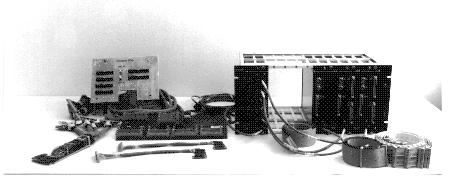 |
The expertise gained in the previous upgrades resulted in Metsähovi producing four VLBA4 electronics upgrade kits for the EVN in its ``VLBA-to-MarkIV'' (VIV) project. The goal of this project is to ensure that all EVN VLBI data acquisition systems (both MarkIIIA and VLBA systems) get upgraded to MarkIV performance level. The end result of an upgraded VLBA terminal is called ``VLBA4''.
The VLBA4 upgrade will quadruple the speed and double the capacity of the VLBA data acquisition terminal.
Metsähovi has received an order of two more VLBA4 upgrade kits and one is under negotiation.
2.1.5 Radio Spectrum Monitoring and Protection
Project Team: Engelberg, Mujunen, Oinaskallio, RönnbergThe radio spectrum monitoring of interesting frequency bands continues normally, however for the most of 1999 it was stopped due to a problem in the antenna rotating system and due to a failure of the IFR spectrum analyzer.
The antenna rod was repaired in May and has worked since. The spectrum analyzer was shipped to United Kingdom for inspection of sudden noise level changes during the measurements. This took much longer than was expected-a total of six months i.e.from May until November 1999.
A new version of the radio spectrum monitoring daemon ``spektrd'' was written in October 1999. The program runs continuously collecting detailed RFI spectral information in UTC time-tagged ASCII files. It controls antenna rotation, spectrum analyzer settings, and archiving of the measured values. The system has been up since November 10th 1999. Analyzing and post-processing these raw data files requires further development. Interesting development is on-going at NFRA (Netherlands) where a set of RFI detection and visualization software packages is being developed as a part of an EU project.
After restarting the monitoring campaign in November, it was noticed that the GSM1800 network is growing outside Helsinki area and a 1800MHz base station signal can be measured at Metsähovi, although the signal level is 30dB lower than the GSM900 system signal.
2.1.6 Computing Infrastructure
Project Team: Mujunen, EngelbergMetsähovi observatory site is connected to the Internet using a 2Mbit/s dedicated leased line to university computing center. A stand-alone NAT LANB/290 IP router routes TCP/IP network traffic between Metsähovi LAN and Internet WAN. Four 28.8k modems provide dial-in facilities for observatory personnel.
This year almost all of our Linux computers were upgraded from Debian/GNU/Linux (see the URL http://www.debian.org) version 2.0 to 2.1. The Debian ``dselect/dpkg'' mechanism offers continuous upgradability package-by-package without the need to reinstall the operating system from scratch. It seems to work surprisingly well, since we have had a couple of computers undergo a 1.1 -> 1.2 -> 1.3 -> 1.3.1 -> 2.0 -> 2.1 chain of upgrades.
IDL version 5.1 is still being used on ``kurp.hut.fi'' (2floating licenses) and on two Linux computers dedicated to solar research. Version 5.2 was discovered to be incompatible with Debian/GNU/Linux and therefore its installation has been postponed; version 5.3 is waiting for to be tested for compatibility.
The ``15APR99'' release of AIPS VLBI data and image processing system was installed by visiting scientist Carl Gwinn (see section 5) at our university site.
For electronics development, PADS PowerLogic and PowerPCB2.1 were used, together with Lattice/Vantis DesignDirect1.1 CPLD development system.
2.1.7 Data Collecting and Archival
Project Team: Mujunen, EngelbergMetsähovi main NFS server ``/home'' continues to be the same 32GB four-disk RAID0 disk array which was installed in 1998. The hard disk array enclosure has two sets of four 9GB hard disks, ``/home'' and ``/backup''. All user files can thus be backed up ``on-line'' using the Linux ``mirrordir'' command in less than an hour. This process was automated by using a ``cron'' job to execute mirroring daily at 18:30 local time.
Backing up ``/backup'' (instead of ``/home'' directly) on DAT makes tape backups more consistent since ``/backup'' does not change during the DAT-``tar'' procedure. It also provides a snapshot of yesterday's files which allows us to recover from, for instance, accidental user file deletions and similar mishaps.
The necessary infrastructure for multiple concurrent software developers in the form of ``/home/cvs'', a common CVS repository, has been found extremely useful. CVS (Concurrent Versions System) keeps track of the evolution of source code and documentation files and allows multiple developers have private ``sandbox'' development copies of the same set of files. Later changes can be merged back to the common repository version of each file. CVS conventions at Metsähovi are documented in a laboratory report ``Using CVS at Metsähovi''.
The additional ``data warehouse'' NFS server ``/data'' created on ``data.kurp.hut.fi'' was put into full use in 1999. The server uses a similar Linux RAID0 setup as what was used for ``/home''. Two 9GB Ultra-Wide SCSI hard disks were combined for 18GB of total ``/data'' disk space and another two disks make up on-line ``/backup''.
``/data'' is reserved for continuous log and data file storage for different components of Metsähovi observation system (see section 2.2). Environmental and auxiliary measurement information is collected by background daemons and archived in ASCII files, one file per each UTC day (``yyyymmdd.log'').
A common simple line format is being used. Each line of the text data files includes the UTC timestamp of the observation moment (with the precision of ten milliseconds), the name of the observed parameter, and the numeric value of it (see Figure 3). Other timestamped line formats can also be used, and the common background archiver daemon ``arranger.pl'' will continue to function normally to take care of fail-safe moving of archive data to the common ``data.kurp.hut.fi'' server.
 |
Hydrogen maser conditions were monitored with a Linux software daemon ``efos9d''. The latest version of the software measures 34 monitoring channels and the maser frequency value and saves them locally and afterwards these daily files are being moved to the main data archive located in ``data.kurp.hut.fi''.
Network timing protocol configuration was developed a little mainly due the new versions of ``xntp'' program. Recently the timing accuracy has reached the desired level, i.e.all the computers using ``xntp'' are within ± 0.1 second accuracy using same time in their clocks.
2.1.8 Data Monitoring
Project Team: Könönen, Mujunen, VileniusThere are several different types of non-astronomical data which are observed and collected non-stop at Metsähovi Radio Observatory. The purpose of the data is to aid the observations and to help the maintenance and upgrading of the instruments.
At the present this kind of data is received from the two weather stations, a spectrum analyzer, an ADAM/NuDAM control/monitor network, and the EFOS-9 hydrogen maser. The data is saved in a the rack-mounted Linux PC ``data.kurp.hut.fi'' where main ``/data'' directory includes separate subdirectories for each data source. Daily files (``yyyymmdd.log'') are saved to these subdirectories. These files consist of the UTC time stamped monitoring values.
There is a demand to view the data graphically, monitored values versus time. For that reason a CGI program was developed. The choices for a programming language and a plotting program (in the Linux computer environment of the Metsähovi Radio Observatory) were the Perl programming language and the Gnuplot plotting utility on account of their flexibility of handling text format data which includes time parameters and overall compatibility with each other, with system commands, and with HTML scripting.
The first allotment was the presentation of the weather station data and the EFOS-9 hydrogen maser data (programs ``Weather'' and ``Efos9''). After that the code was generalized to enable also the handling of the spectrometer data which has a slightly different saving format (``multi-browsing'' program ``MB'').
The present modification of the generalized ``MB'' program searches the ``/data'' directory for the text files which include the information of the data types and parameters. It then creates the Web inquiry forms which are based on this information. In the forms the user has a choice of data types, parameters, a time period and presentation of data. Available options are e.g.the number of parameters in one graph, the parameter axis, a plotting colour, etc. The resulting GIF files (see Figure 4) are shown on the screen and they are available via links.
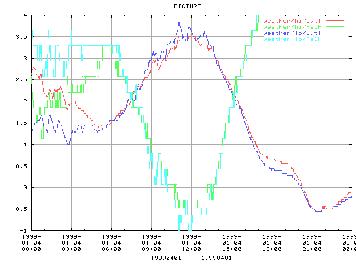 |
Another CGI script, ``latest.cgi'', makes it possible to easily create new HTML Web page templates which can contain references to latest data values available in standard ``yyyymmdd.log'' log files available on ``/data''. An initial Web page has been created which presents an illustration of Metsähovi radome and antenna together with embedded radome and antenna dish temperatures. It is anticipated that a varied collection of application-specific Web pages based on ``latest.cgi'' value substitutions will emerge in short time.
The CGI programs are available at the location ``http://kurp.hut.fi/local/'' which initially limits the access to the computers on-site at Metsähovi.
The potential extensions are the possibility to add the calibration offsets to the monitored ``raw'' data values and the possibility to average out the values. For this purpose, the determination of the most important weather offsets was performed and a report of this was made available in the laboratory report series (see section 3.4).
2.2 Antenna Control System Upgrade
Project Team: Mujunen, Engelberg, Myyry, Oinaskallio, RönnbergYear 1999 resulted in significant progress in the ``Phase 2'' of our antenna control system upgrade. This was mainly because most project members were able to devote as much as 50 % of their time to the antenna project.
The overall architecture of the observation system is presented in Figure 5. The main objective is to offload observation/measurement tasks across multiple industry-standard PCs running the freely available Linux operating system. To attain high time accuracy common station time is distributed with 5MHz and 1pps signals to all participating computers. Hardware clock counters are used to make precise common sub-second time easily available in all PC Linux software, and higher-level common UTC time is distributed from GPS monitoring subsystem using the ``xntp'' Network Time Protocol software package.
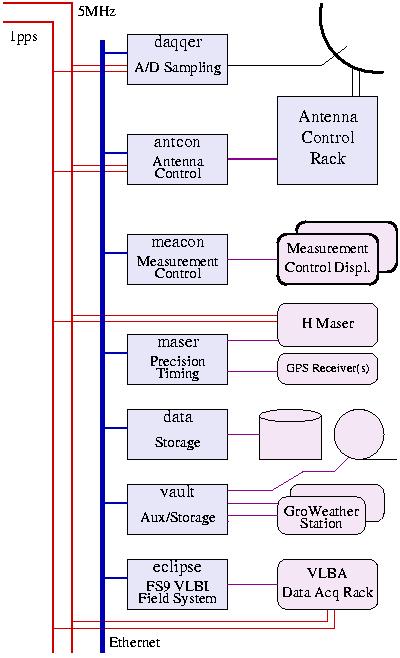 |
Heidenhain RON806 optical encoders have been in use as the main Az-El axis encoders since 1996 and they have given us the benefit of a (at least) tenfold improvement in encoder accuracy when compared to old Inductosyns. RON806s exhibit very little periodic/geometric distortions and they deliver noise-free and repeatable sub-millidegree accuracy. Much of this accuracy can also be attributed to careful mechanical fitting and alignment of the encoders; also the Heidenhain-supplied IK121 PC ISA encoder interface board provides excellent results when it interpolates the 11 µA sinusoidal current signals for 1024-fold resolution improvement over the optical 36000lines per revolution grating line count.
To make it possible to implement a new digital servo system the same PC computer which receives RON806 encoder signals must drive the DC motors. This setup is presented in Figure 6.
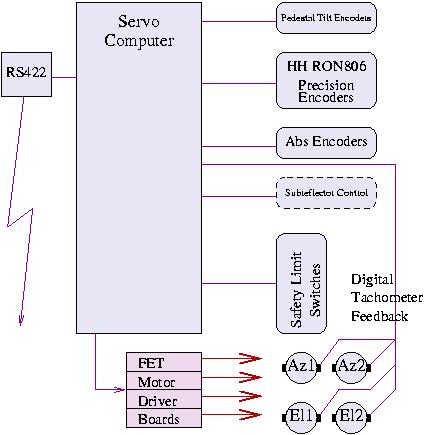 |
Physically the servo PC and the motor control electronics reside in a compact rack enclosure in the antenna pedestal, in close proximity of the Az-El encoders. The maximum cable length from RON806 encoders to the IK121 PC ISA encoder interface board must not exceed 15meters and this dictated the placement of the servo PC.
2.2.1 Dedicated Hardware
When the decision was made to continue using the same type of low-inertia DC brush motors for antenna movement as what was used before, a search was made to find a suitable commercial DC motor drive solution. One driver board from Maxon (Switzerland) was even tested and found inadequate for our 28VDC/8A motors. Thus it was decided to develop and build a computer-controllable PWM DC motor driver solution.
In autumn 1998 our ``FET30'' DC motor PWM FET driver board was developed to its third prototype stage. It was rigorously tested to ensure that we have achieved robustness against motor and software failures. In spring 1999 we continued to develop ``PWMISA16'', a PC ISA expansion board which allows PWM controlling up to five FET boards (four antenna movement motors and one shared subreflector motor drive). PWMISA16 also contains a 5MHz/1pps hardware clock counter which makes sub-second time available with 1 µs resolution. A watchdog counter is provided, too, and a software failure to refresh it within 1.5 seconds causes the PWM outputs and enable relay outputs to be disabled.
To get information about the actual motor speeds digital quadrature tachometers (Heidenhain ERN420 10000counts/revolution) were installed in each motor to replace the old analog generator-type voltage tachometers. Commercial quadrature encoder PC ISA boards were evaluated, as well as an integrated IC solution from HP (HCTL-2016). The cost of complex and large PC ISA boards was so high that we were able to develop a simple ``QDRxxx'' interface board at roughly the costs of one ready-made board. Our board is easier and cheaper to duplicate, thus we were able to use it in addition to motor tachometers also in the user interface manual ``knobs'' and also in the space weather system presented in section 2.7.5.
To make the antenna quick, easy, and familiar for existing users we decided to create a computer-simulated conventional control panel called ``ANTBOX'' with indicator LED lights, pushbuttons, and manual adjustment ``knobs''. The knobs were implemented using HP HEDS series panel-mounted quadrature encoders connected to our ``QDR05R'' interface board. This makes knob positions immediately available in numeric form to the antcon control Linux PC which can then simulate any manual changes/adjustments required such as adjusting manual offsets, moving the antenna at manual angular velocity etc.
The LED indicator lights were also realized under full antcon computer control. A simple ``LEDIM'' control board allows up to 16 LEDs to be set to ``off-dim-normal-bright''. ``LEDIM'' also provides routing for ``ANTBOX'' pushbutton cabling.
A major design issue in the development of our new control system was that there should be no hardware or software single failure which could lead to antenna movement beyond its physical limits. A +24VDC chain of interlock switches is used and this voltage is used to power master relays on an ``ANTREL4B'' board. It drives the main contactors which are used to connect motor power supplies and motor wiring to the FET driver boards. The ``ANTBOX'' control panel includes also a ``STOP'' pushbutton to switch off the +24VDC interlock voltage-this results in main motor contactors to be deprived of their supply power and the antenna stops immediately.
As a remote site, Metsähovi often experiences power outages, especially during heavy snowfall in winter and during thunderstorms in summer. It was decided to adequately protect all antenna control system components with uninterruptible power supplies so that observing can continue for 15-20minutes regardless the loss of power. For this purpose three 1600VA identical UPS units were installed, the first to protect antenna control, the second to protect receivers and data acquisition computers, and the third for the cryogenic compressor in antenna pedestal. Additional UPSes were already in place for data server computers, the VLBA DAR, and the Hmaser.
2.2.2 Cabling
All cabling between the antenna pedestal and the control room was dismantled and replaced with a new set of cables. Four thick RG214 cables are provided for receiver IF connections for up to two concurrent dual-polarization receivers. Twelve thin RG223 cables are intended for general-purpose analog interconnects such as total power etc. Two 24-pair instrumentation cables supplement the cabling.
Dedicated antenna control cables were reduced to only:
- 1.
- A bidirectional RS422 connection between ``antcon'' and ``antup1''.
- 2.
- A bidirectional audio connection for operator conversation between the control room and the antenna pedestal.
- 3.
- Safety interlock switch wiring to prevent antenna from moving if there are physical obstacles in its path.
- 4.
- UPS 230VAC power.
2.2.3 Computers
For the antenna pedestal servo rack presented in the above section 2.2.2 we needed a relatively compact PC with sufficient space for expansion boards. Three identical ``antup1/2/3'' PCs were acquired, the first for main antenna, the second as a spare, and the third for the space weather system (presented in section 2.7.5).
Several rack-mounted Linux PCs (see Table 1) for antenna control were acquired and mounted in our control rack.
| Name | Function |
| antcon | Antenna pointing control. |
| daqqer | Analog data acquisition/sampling. |
| meacon | Observation control; ADAM/NuDAM, weather. |
| data | On-line data archive. |
2.2.4 Weather Stations
A pair of Davis GroWeather (see ``http://www.davisnet.com'') weather stations acquired from a local systems integrator, Envia Oy, have performed satisfactorily. The connection to the ``lo'' station was intermittent, however, and the Davis RS232 optoisolators seemed like to be the culprit. (See Figure 7.)
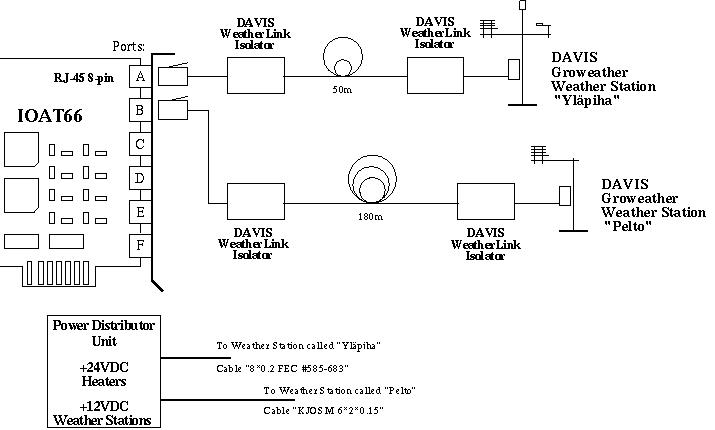 |
The optoisolators were replaced with isolated RS232/RS422 converters designed in-house. RS232 is not reliable with long cable runs (50/180m in this case) whereas RS422 works reliably up to 1000m and more of twisted-pair cable. Our converter combines complete electrical isolation (including power supply and ground) together with standard RS422 drivers with surge suppression, thus forming a robust interface for outdoor cabling.
Both GroWeather stations feature temperature, barometric pressure, and relative humidity sensors. The first station is located near the telescope and radome, and the second one is a bit farther away and about 10meters lower in altitude. It acts both as a backup of the first station, as a ``second opinion'', and also hopefully as an ``early warning'' system, as mist and dew seem to appear first in the low-altitude ``valley'' area. The ``hi'' station includes additional solar radiation, wind speed and direction, and rain gauge sensors which were omitted in the ``lo'' station.
Weather station data collection software ``weatherd'' was put into full use after completion and installation of the isolated RS232/RS422 interface adapters. Software saves all data from stations in two different locations ``/data/weather/hi'' and ``/data/weather/lo'' based on the physical location of stations.
The ``MB'' software presented in section 2.1.8 makes it easy to generate customized weather plots using a Web-based end-user interface. Fundamental sensor calibration measurements were conducted by Esa Vilenius and the results are documented in a laboratory report HUT-KURP-17, 2000.
2.2.5 ADAM/NuDAM
In 1999 the central ``hub'' of our ADAM/NuDAM monitor/control network was re-built in a permanent rack enclosure. Twisted-pair from practically all areas of the observatory site terminate in this ``ADAM/NuDAM Box''. (See Figure 8.)
The network is based on commercially available ADAM/NuDAM A/D, D/A, and digital I/O modules which are connected together using a multidrop RS485 network implemented with single twisted pair wiring. These modules allow centralized and coordinated monitoring and control of discrete adjust values spatially dispersed across the whole observatory site. A single Linux PC masters the RS485 network bus while a TCP/IP server process running on it makes all ADAM/NuDAM modules equally accessible from any computer on the Metsähovi LAN using a simple, telnet-style protocol.
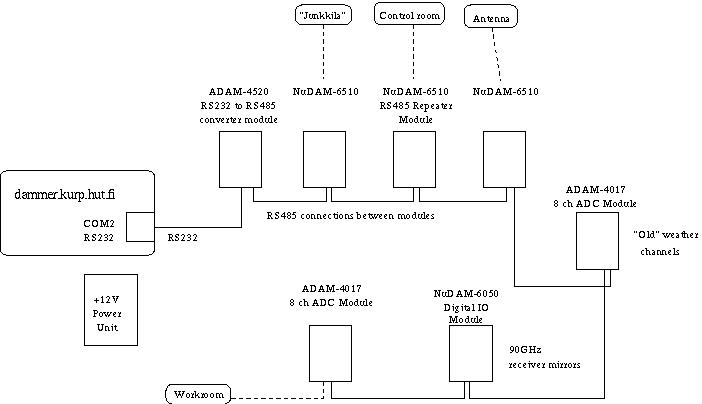 |
2.2.6 Data Acquisition (A/D)
For analog data acquisition a Datel PCI-416M 4-channel 200kHz simultaneous sampling 16-bit A/D converter board was purchased and installed in ``daqqer''. A Linux device driver ``pci416.o'' for the board was written and verified to be able to continuously stream in samples from all four channels at a sampling rate of 10ksps, for a total data aggregation rate of 80kB/s.
The initial version of ``BEclock'' back-end clock generator box was built. It includes 5kHz active sampling filters for four differential input channels and a 1pps triggerable 10kHz sampling clock (synchronized to 5MHz Hmaser reference for absolute time tagging).
Linux-based data acquisition software will be built to utilize the time synchronization provided by ``BEclock''. All further integration (beyond fixed 10kHz sampling) and handling of beam switching will be done in software.
2.3 Extragalactic Radio Sources
Research Group at Metsähovi: Urpo, Karlamaa, Lähteenmäki, Teräsranta, Tornikoski2.3.1 Monitoring of Quasars
Project Team: Teräsranta, Lähteenmäki, Tornikoski
The monitoring of quasars at Metsähovi Radio Observatory continued in 1999 for the 19th year. Our main sample consists of 85 AGN (Active Galactic Nuclei), about equal number of BL Lac objects, HPQ's (high optical polarization quasars) and LPQ's (low optical polarization quasars). As the Metsähovi antenna was under maintenance from May to November, the total number of QSO observations was quite modest, only about 1900. The total number of observations since 1980 is now over 43000. All the observations during 1999 were at 22 and 37 GHz.
Altogether 11 persons took part in the QSO observations during 1999, most of them being students from the Turku University, whose salary was partly paid by Tuorla Observatory. Nearly 20 % of the observations were done in automatic mode, mostly during the cold season, when dew is not expected on the radome. The observers were: Harri Teräsranta (HT), Anne Lähteenmäki (AL) and Merja Tornikoski (MT) from the Helsinki University of Technology, automatic observations (AU), Tuomas Niemelä (TN), Seppo Wiren (SW), Matti Koskimies (MK), Pertti Koivisto (PKo), Niko Varjonen (NV), Jani Achren (JA), Tuomas Savolainen (TS) and Markku Lainela (ML) from the Turku University and their share of the observations during 1999 is shown in Figure 9.
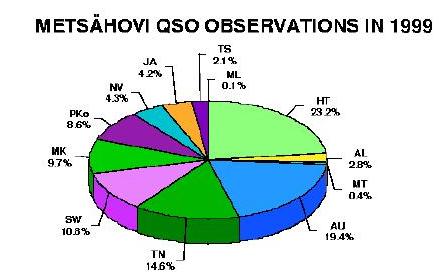 |
An example of our long term monitoring can be seen in Figure 10, the flux of the quasar OA 129 at 22 and 37 GHz since 1981.
 |
The prelaunch observations of foreground sources for the ESA Planck mission were started with observations at 22 GHz in the first stage. The removal of strong foreground sources from the Planck maps will increase its sensitivity, especially in the narrow field of view. The sources observed here in the first stage are limited to Northern part of the sky, declinations 0 - +75 and flux density higher than 0.5 Jy at 1.4 GHz. The spectral index &aplha; between 1.4 and 4.85 GHz is another selection criteria, the sources are observed from the flat spectrum ones towards the steeper spectrum ones. In the end of the year 1999 the sources with &aplha; = -0.3 are nearly completed. The number of sources will increase as the spectral index gets smaller due to a larger fraction of ordinary radio galaxies. The &aplha; of ordinary radio galaxies can be considered constant in the radio-mm region, being around -0.7 and they are mostly nonvariable. Thus the effect of radio galaxies can be easily removed from the Planck maps. The sources with a flat spectrum up to higher frequencies (100GHz) tend to be variable and also quite strong at higher frequencies, at least during the outburst stages. A small part of sources with a steep spectral index in the lower frequencies (1.4-4.85 GHz) are in reality flat spectrum sources and will show blazar type behaviour. Their steep spectral index at lower frequencies could be due to the surveys observations at the higher frequency (4.85 GHz) being in the relatively quiet phase, as the 1.4 GHz observation has been during a more active phase. A single epoch observation of our sample will still leave some flat spectrum sources undetected, as they might be in a low flux state during our observations. Thus 2-3 observations within 2-3 years should give a better estimate of the duty cycle. It must be noted, that our present rms error levels around 50 mJy with a typical 30 minute integration leave some of the sources undetected in their low stage. The new detected flat spectrum sources will be added to our observation sample. Some of the new sources in the sample have not yet an optical counterpart. Their identification has been started in co-operation with the Tuorla Observatory.
Although the launch of the Planck is still many years in future and the lower flux limits for the interfering sources at specific frequencies is not fixed, the early preparation can be justified by the flight of two important gamma-ray observatories before Planck, namely the Italian AGILE and NASA's GLAST. Both AGILE and GLAST will have a large field of view, in order of 2.5 sr for AGILE and even larger for GLAST. Together with planned long integration times (months) it will lead to many new gamma-ray sources to be detected. Also their duty cycle can be studied better than earlier. The close connection between gamma-ray emission and mm-radiation has been demonstrated in our previous works, but due to the poor temporal resolution in the gamma- ray data, the events can not yet be fully connected. All of the gamma-ray emitting AGN should also be flat spectrum radio sources and thus both AGILE and GLAST should complete our sample for the Planck mission.
2.3.2 SEST Observations
Project Team: Tornikoski, Teräsranta, Lähteenmäki, Valtaoja (Turku), Lainela (Turku)Our long-term high radio frequency (90 and 230GHz) monitoring of AGNs with the SEST telescope was discontinued in 1998, but we still use the SEST for individual short observing projects related to our group's work on AGNs.
1. High-frequency spectra of faint radio sources and the extragalactic radio background.
This project is related to the Planck-foreground activities of the Metsähovi group. With our group's ground-based observations we aim to get a meaningful estimate of the contribution of extragalactic radio sources in the high radio frequency domain to the observed background as a prediction for the Planck mission. The SEST observations are essential to complement this study in order to extend the sample to the southern sky and to allow us to estimate the extragalactic foreground contribution from the high-frequency tail of the spectrum of radio sources.
Studying a full sample of extragalactic radio sources will give us a true estimate of the shape of the millimetre spectrum of these sources, including the fainter (at low radio frequencies) sources which are routinely excluded from flux-limited samples. It is worth noting that also non-detections (under good observing conditions) will offer us valuable information when estimating the contribution to the extragalactic background. Another goal, which is partly related to the goals of the Planck mission but also interesting per se, is the aim of finding sources with flat or inverted spectra in the GHz range.
In June 1999 we made our first SEST observations related to this project. The data are now being analyzed and will be published in 2000.
2. Gamma-ray loud and quiet southern AGNs
This project is connected to our earlier SEST studies of gamma ray sources and candidates.
The main goal of this study is to get a more thorough understanding of the relationship of the radio and gamma ray activity of AGNs. We aim to get a complete picture of the radio behaviour of a selected sample of southern sources, both gamma ray loud and quiet ones. We have monitored these sources with the SEST also earlier, and now that the EGRET lifetime is ending, we wanted to have our last look at these sources also at the SEST frequencies in order to have a full understanding of their radio states and the variability behaviour during the whole CGRO mission lifetime.
We will compare the radio properties of the gamma ray loud and quiet sources. Were the sources that were detected with the EGRET active also in the millimetre domain at that time? Were there times when they were in the EGRET field of view and not detected, and they were in a low radio state at that time? Are there any notable differences in the radio variability behaviour, amplitude and timescales, between the gamma ray loud and quiet AGNs?
This project was granted SEST observing time in October 1999, and the data are now being analyzed.
2.4 Planck-Related Science in Metsähovi
Project Team: Lähteenmäki, Teräsranta, Tornikoski, Urpo
The Planck satellite is one of European Space Agency ESA's main missions of the decade. It will measure the 3K sky background radiation at several millimeter frequencies. This cosmic microwave background (CMB) radiation, observed from all directions in the sky, exhibits how the Universe looked shortly after the Big Bang. Examining the CMB at the high resolution and sensitivity of the Planck satellite will answer some of the fundamental questions about our Universe. The launch is scheduled for 2007 and the all-sky catalogs will be available in 2010.
The Planck satellite data can also be used for AGN science. The Low Frequency Instrument (LFI) data, in the range of 30 - 100GHz, will comprise an enormous database of active galaxies and quasars. In fact, the Planck all-sky catalog of AGNs will be the most complete so far. This data can be used in traditional AGN research, e.g., in multifrequency spectral studies or in comparison with other frequencies.
However, the so interesting AGNs are a nuisance to the CMB measurements, and are regarded as mere foreground objects one should try hard to get rid of. This is why the Metsähovi radio telescope will be used in a search for sources whose spectra peaks at the LFI frequency range. The number, the strength, and the variability of these Gigahertz Peaked Spectrum (GPS) sources should be known in order to produce accurate CMB maps. The search for new GPS sources has already started in Metsähovi and at SEST, and simultaneous observations during the Planck satellite flight are being planned. The Metsähovi measurements will also be valuable when analysing the Planck all-sky AGN catalogs.
We have started a collaboration with the LFI Consortium foreground team, and there is an agreement on the exchange of data and on the scientific work contribution. The detailed concept of the foreground team, and its agenda, are expected to shape up during the year 2000. The Planck satellite project integrates naturally to the AGN project in Metsähovi, and provides new insights on the ongoing research as well as opens up entirely new possibilities both in science and in inter-observatory co-operation.
2.5 Observations with Other Facilities
Swedish-ESO Submillimetre Telescope (SEST), Chile:
21.-24.6. (46 hours) ``High frequency spectra of faint radio sources, and the extragalactic radio background''. P.I. M. Tornikoski, Co-Is H. Teräsranta, E. Valtaoja (Turku), M. Lainela (Turku), observer: M. Lainela.
6.-11.10. (37 hours) ``Gamma-ray loud and quiet southern AGN'', P.I. M. Tornikoski, Co-Is H. Teräsranta, E. Valtaoja (Turku), M. Lainela (Turku), observer: M. Lainela.
VLBA: 18.5. (3.5 hours) ``The bursting gamma ray source, PKS 2255-282'', P.I. S. Tingay, Co-Is M. Tornikoski et al.
``Monitoring extremely variable spiral III ZW 2'', P.I. H. Falcke, Co-I H. Teräsranta. Observations with the VLA during: 8.1, 22.2, 23.3, 23.4, 13.5, 22.6, 7.7, 1.8, 28.8, 20.9, 18.10, 11.11 and 5.12 1999.
2.6 VLBI Research
Research Group at Metsähovi: Urpo, Karlamaa, Liljeström, Mujunen
2.6.1 EVN
Project Team: Urpo, Engelberg, Karlamaa, Mujunen
Metsähovi participated in two EVN 22 GHz sessions in February and in March with success. 22 GHz receiver has worked without problems. In March 1999 Metsähovi participated for the first time in an international VLBI session at 43 GHz. The array consisted of all VLBA antennas, phased Y (13 antennas), Effelsberg, Metsähovi, Onsala, Yebes and Medicina. Metsähovi produced again fringes. Metsähovi participated in this session of interesting bit of science and the results will be published in Nature. The 43 GHz receiver noise temperature is around 65 K. The RCP channel is still out of order because gate bonding of one of the HEMTs is damaged. We don't know yet how to repair it. 86 GHz receiver is available and operational.
Kaj Wiik has moved to Tuorla Observatory, Turku, and he is not actively participating Metsähovi VLBI group activities. His main interest is in CMVA. PhD student Mika Perttula has left from the Metsähovi VLBI group, he is currently working at Finnish Telia.
Compressor cover was built to protect the compressor during winter. It has worked fine, no problems even at temperatures less than -25 C.
2.6.2 CMVA, Coordinated Millimetre VLBI Array
Project Team: Urpo, Engelberg, Karlamaa, Valtaoja (Turku), Wiik (Turku)Metsähovi participated in one CMVA session in 1999 with success.
2.6.3 Space VLBI
Project Team: Urpo, Liljeström, Tornikoksi, Valtaoja (Turku), Wiik (Turku)Metsähovi continued to participate in the space VLBI projects HALCA (Japan) and Radioastron (Russia). In 1999 there were no 22 GHz sessions with HALCA but scientists from Metsähovi were members of several accepted HALCA science projects at lower frequencies. The progress of Radioastron was slow in 1999 but Metsähovi continued as a member of RISC (Radioastron International Science Committee).
2.6.4 FS Support
Project Team: MujunenSince 1995 Metsähovi has participated in and contributed to the development of the Field System, software used to control VLBI Data Acquisition Racks during VLBI observations. Currently we participate in a three-year European Community Contract FMGE-CT98-0101 program for enhancing EVN together with five European institutes. Our efforts concentrate on enhancing the FS software to support evolving observational techniques being developed in this EU program.
In 1998 the third generation of the FS adaptation of the Linux operating system was created, called ``FS Linux 3'', based on Debian/GNU/Linux 2.0r5. In February 1999 it was presented in EVN TOG meeting (Noto, Catania, Italy) and CD-R disks were distributed. In 1999 an increasing number of stations migrated to using FS Linux 3.
A considerable level of Linux support via email was given to collaborators at NASA GSFC geodesy VLBI project, Ed Himwich and Nancy Vandenberg. This included about 170 emails sent in 1999, in addition to email support sent directly to stations.
The European FS FTP archives at Metsähovi (``ftp://kurp-ftp.hut.fi/pub/fs*'') are the primary source of FS Linux files and they also act as the primary means for EVN stations to access mirrored FS files from ``ftp://gemini.gsfc.nasa.gov''.
2.7 Solar Research
Research Group at Metsähovi: Urpo, Koistinen, Pohjolainen, Phan2.7.1 Solar Data Analysis
Project Team: Pohjolainen, UrpoMetsähovi solar radio maps can be analysed using the IDL-based software developed by S. Pohjolainen. The latest version is available in the Web, at http://www.hut.fi/~spo/idl.html, with guidebooks both in English and in Finnish.
2.7.2 Solar Polar Features at mm-Waves
Project Team: Pohjolainen (Observatoire de Paris, France), Portier-Fozzani (LAS-CNRS, Marseille, France), Riehokainen (Turku), Valtaoja (Turku)
Metsähovi radio maps at 87 GHz (3.5 mm) from 1996-1997 have been analysed and compared with nearly-simultaneous SOHO/EIT and YOHKOH/SXT images. Emphasis was given to comparing polar radio brightenings with features seen in EUV, but also many radio depressions and their EUV and SXT counterparts were analysed. The radio enhancements were found to correlate with bright points, polar plumes or plume bases, and EUV bright diffuse structures. No uniform brightness was found inside the coronal holes: the holes appeared generally as radio dark, with local brightenings inside them. The visibility of radio bright coronal holes seemed also to depend on how much of the polar area was exposed, due to the variation of the B0-angle. The analysis and results are presented in Pohjolainen et al. (A&AS, in press).
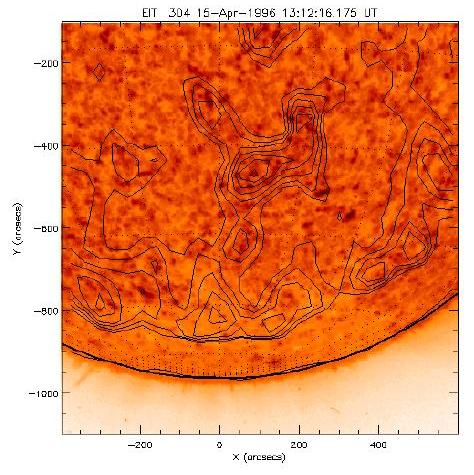 |
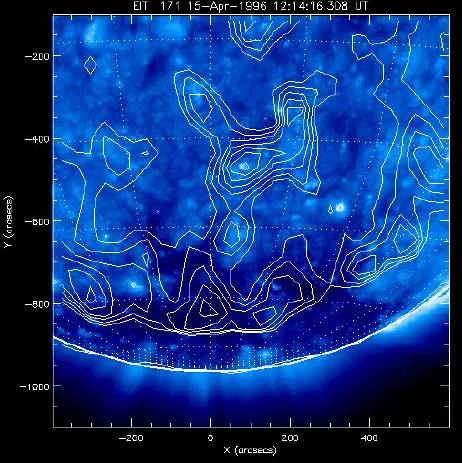 |
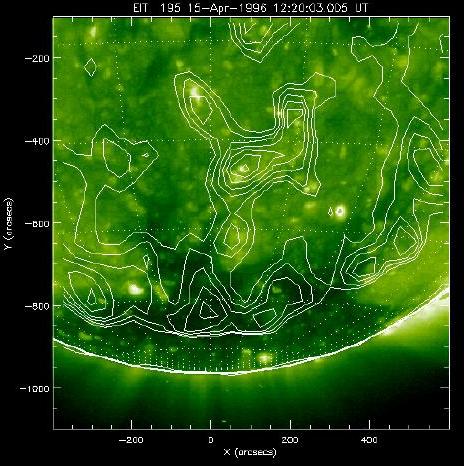 |
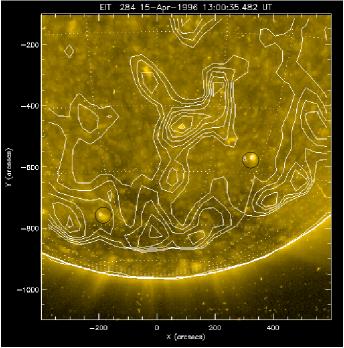 |
A similar analysis was done using the Metsähovi 3.5 mm radio data and TRACE EUV and UV data from 1998 (Pohjolainen et al., 1999, ESA SP-448). The results were similar to the EIT-Metsähovi comparison, only now the resolution in EUV was much better and smaller features could be recognized. Many EUV bright points - some of them were also seen in UV - were found to correlate with locations of enhanced radio emission. This suggests that some of the radio brightenings are formed very low in the solar atmosphere. Also local radio brightenings inside coronal holes were observed, with no obvious reason for the enhanced millimetric emission.
